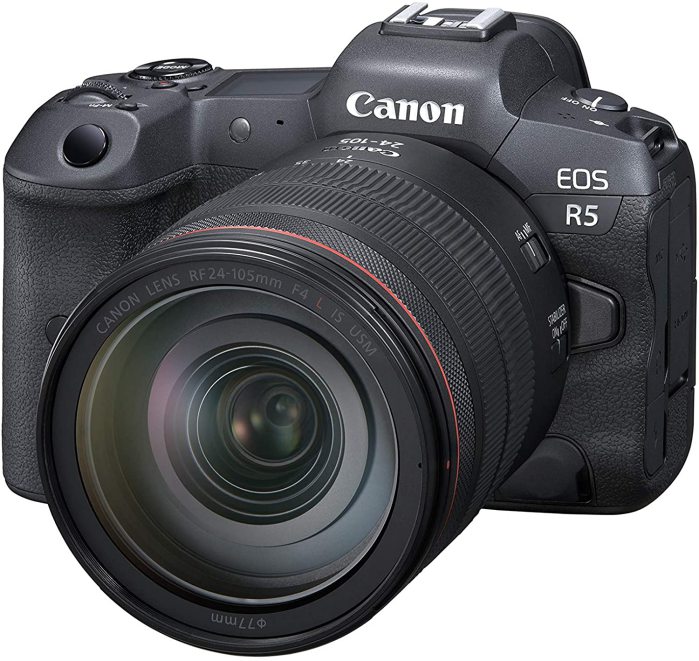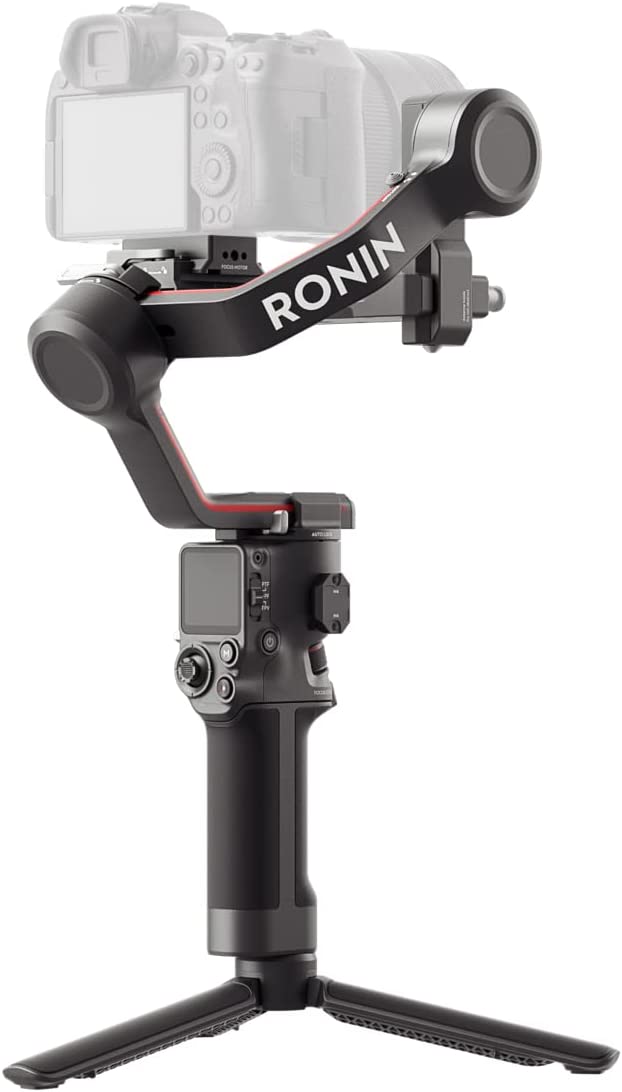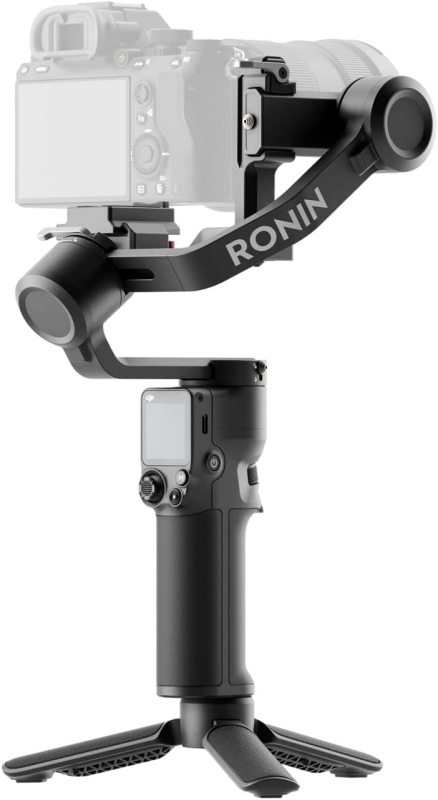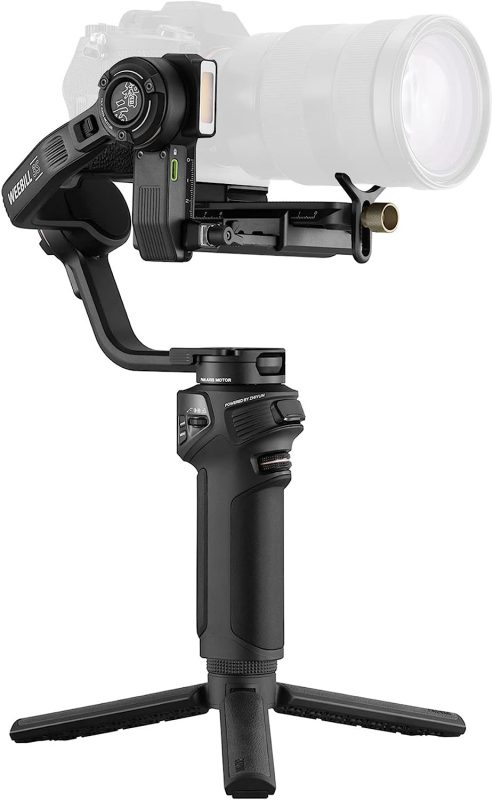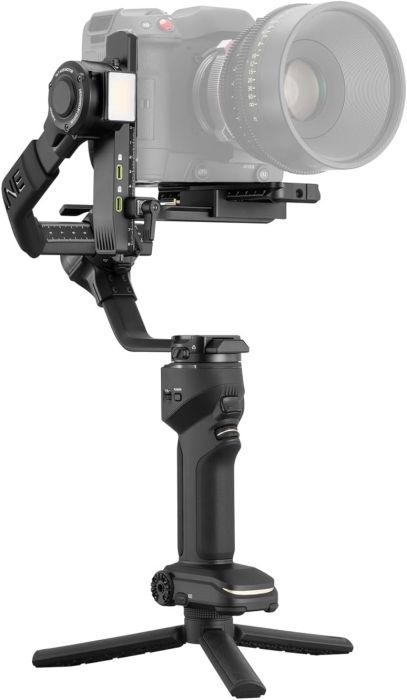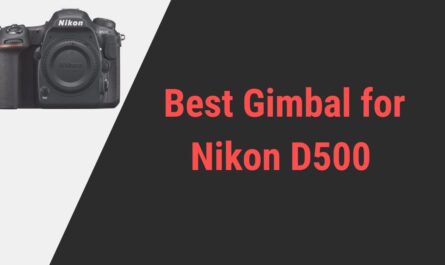In the journey toward exacting precision and cinematic brilliance, the search for the perfect gimbal to accompany the Canon EOS R5 rises to prominence.
With the continuous evolution of photography and videography, the demand for seamless stabilization solutions amplifies, particularly when partnering with a powerhouse like the Canon EOS R5.
Canon EOS R5
- Sensor – 45-megapixel full-frame CMOS sensor
- Image Processor – DIGIC X
- Autofocus – Dual Pixel CMOS AF II with 1,053 AF points
- ISO Range – 100-51,200, Expandable to 50-102,400
- Shutter Speed – 1/8000 to 30 seconds, Bulb mode
- Continuous Shooting – Up to 20 frames per second (mechanical shutter), Up to 12 frames per second (electronic shutter)
- Viewfinder – 0.5-inch OLED EVF with 5.76 million dots and 100% coverage
- LCD Screen – Vari-angle 3.2-inch Clear View LCD II touchscreen with 2.1 million dots
- Video – 8K DCI, 8192 x 4320 at 30p internal recording, 4K DCI, 4096 x 2160 at 120p internal recording
- Video Compression – RAW, 10-bit 4-2-2 H.265 (8K) and 10-bit 4-2-2 H.264 (4K)
- Image File Format – RAW (14-bit Canon CR3), JPEG, HEIF, C-RAW
- Connectivity – Wi-Fi, Bluetooth, USB-C, HDMI (out), 3.5mm microphone, headphone jacks
- Memory – Dual card slots (CFexpress and SD UHS-II)
- Battery – LP-E6NH rechargeable lithium-ion battery
- Dimensions – 138.5 x 97.5 x 88 mm
- Weight – Approx. 738g (1.63 lb), including battery and memory card
Note:
All the gimbals mentioned here are tested with Canon EOS R5 and work perfectly fine.
| DJI RS 3 (Best Overall)

|
| DJI RS 3 Pro (Most High-end - Highest Payload Capacity & Comes with Advanced Features)
      |
| DJI RS 3 Mini (Budget Pick)
      |
| Zhiyun Weebill 3S
      |
| Zhiyun Crane 4
      |
This mirrorless gem, acclaimed for its groundbreaking capabilities and outstanding imaging quality, necessitates a compatible gimbal that harmonizes seamlessly with its prowess.
From capturing sweeping vistas to seizing dynamic action sequences, the pursuit of an optimal stabilizer becomes imperative, promising to unlock the complete visual potential inherent in the EOS R5’s remarkable capabilities.
Finding the right stabilizing tool isn’t just a complementary aspect; it’s a fundamental element in harnessing the full extent of the EOS R5’s extraordinary imaging prowess.
Let us tell you how great the Canon EOS R5 is before you head towards the different gimbals that you can get for it.
About Canon EOS R5 Camera
The Canon EOS R5 stands as a remarkable testament to Canon’s innovation in the realm of mirrorless cameras, boasting an impressive array of features that elevate the photography and videography experience.
Its 45-megapixel full-frame sensor delivers stunningly detailed images with exceptional clarity and depth.
The camera’s autofocus system is a standout feature, offering lightning-fast and accurate focus even in challenging lighting conditions, ensuring sharp and precise captures.
For videographers, the EOS R5 is a game-changer with its 8K video recording capability, a groundbreaking feature in the mirrorless camera landscape. The camera delivers high-resolution video with remarkable detail and flexibility for post-production editing.
Additionally, the 4K video recording at higher frame rates ensures smooth and cinematic footage, catering to a diverse range of filming needs.
The in-body image stabilization system further enhances the camera’s versatility, allowing for handheld shooting with a reduced shake, which is particularly beneficial in low-light conditions or when using longer lenses.
The camera’s ergonomic mirror and Canon’s renowned design excellence offer a comfortable grip and intuitive controls that streamline the shooting process.
Moreover, the EOS R5 embraces connectivity with Wi-Fi and Bluetooth capabilities, enabling seamless file transfer and remote shooting via the Canon Camera Connect app.
Its compatibility with a vast array of RF lenses adds to its versatility, catering to various photographic genres and styles.
The overall performance of the Canon EOS R5 is exceptional, delivering on multiple fronts for both photographers and videographers.
Its ability to capture breathtaking stills, coupled with groundbreaking video capabilities, positions it as a powerhouse in the mirrorless camera market.
The EOS R5’s blend of high-resolution imaging, remarkable autofocus, innovative video features, and robust build quality make it an exceptional choice for professionals and enthusiasts seeking top-tier performance in a versatile and reliable camera system.
Best Gimbals for Canon EOS R5
1. DJI RS 3
The DJI RS 3 is a serious contender in the world of camera gimbals, and let me tell you, it’s quite a powerhouse. First off, it’s designed to carry a variety of cameras, making it versatile for different setups.
You won’t struggle with balance issues because it handles the load pretty well. When it comes to stabilizing your shots, this thing is a champ.
It makes shaky footage a thing of the past, even if you’re moving around a lot. Your videos will come out smooth as butter, giving them that professional touch. What’s cool is its range of intelligent features.
The ActiveTrack 3.0 is a standout, allowing the gimbal to automatically track your subject. So, if you’re filming something on the move, this feature ensures it stays in focus without you having to constantly adjust.
Battery life is always a big deal, and the RS 3 doesn’t disappoint here. You get a good amount of time to film without worrying about it conking out midway.
The controls are user-friendly too. It doesn’t take much effort to get the hang of it, which is great, especially when you’re in the middle of a shoot and need to make quick adjustments.
But hey, it’s not all rainbows and sunshine. Some users find the initial setup a bit complex. It might take a little time to figure it all out, especially if you’re new to gimbals.
And when you’re pushing it to the max with heavier camera setups, some folks have noticed it strains a bit. It doesn’t affect the performance drastically, but it’s something to keep in mind.
Overall, the DJI RS 3 is a solid choice. It brings a lot to the table in terms of stabilization, intelligent features, and ease of use. If you’re into capturing professional-grade footage without the headache of shaky shots, this gimbal could be your new best friend.
However, setting it up might require a bit of patience, especially for newcomers. And when it’s loaded with heavier cameras, it can feel a tad strained, but it doesn’t significantly affect its performance.
In essence, the DJI RS 3 is a worthwhile investment for creators seeking professional-grade stabilization. Its range of features and the level of smoothness it brings to your footage make it a standout choice in the world of gimbals.
Pros
- Easy Stabilization
- Versatile performance
- Intelligent
- Smooth movement
- Reliable
Cons
- Complex at first
2. DJI RS 3 Pro
The DJI RS 3 Pro stands out as a top-tier gimbal crafted to elevate your filming endeavors. This gear offers exceptional stability, ensuring your footage remains consistently smooth, whether you’re filming action-packed scenes or serene landscapes.
The RS 3 Pro impresses with its adaptability, effortlessly accommodating a wide range of camera setups without any balance or compatibility issues. Its versatility makes it a reliable companion for various cameras.
Shaky footage is a thing of the past with the RS 3 Pro. It eradicates unwanted jitters and shakes, maintaining a professional standard for your videos.
Integrating intelligent features like the ActiveTrack system and user-friendly controls further solidifies its position as a reliable tool for filmmakers seeking professional-grade stabilization.
An impressive aspect lies in its intelligent features, particularly the ActiveTrack system. This system smoothly tracks your subjects, allowing you to focus on your shot without constant readjustments.
Moreover, controlling this gimbal is a breeze, thanks to its user-friendly interface for quick setting adjustments. With a decent battery life, it ensures extended filming without frequent interruptions.
However, initial setup might pose a challenge, especially for newcomers to gimbal usage. Additionally, when handling heavier camera setups, it might show slight strain, affecting its performance. Yet, for most setups, it remains highly efficient.
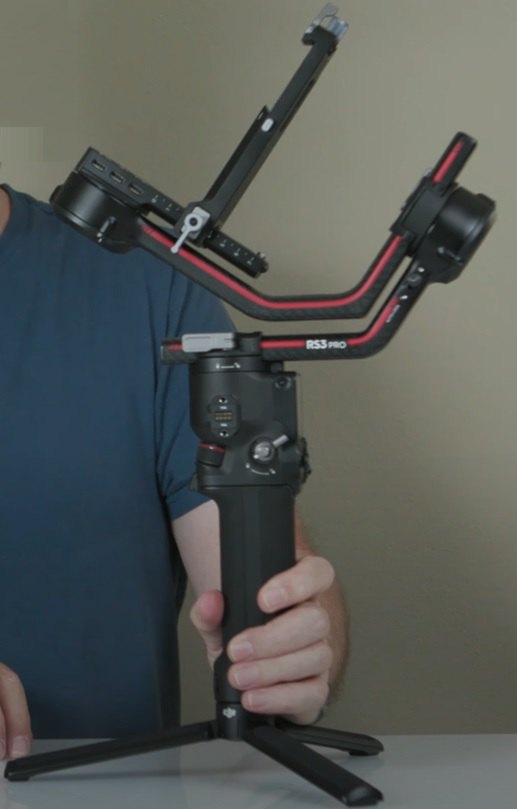

Ultimately, the DJI RS 3 Pro emerges as a fantastic investment for content creators seeking professional-grade stabilization. Its adaptability, stability, intelligent features, and overall ease of use distinguish it in the gimbal market, providing filmmakers with reliable tools to capture impeccable, shake-free footage.
The DJI RS 3 Pro excels as a top-tier gimbal designed to enhance filming experiences. Its exceptional stability guarantees consistently smooth footage, suitable for various shooting scenarios, from dynamic action sequences to tranquil landscapes.
The gimbal’s adaptability is noteworthy, effortlessly accommodating diverse camera setups without encountering balance or compatibility issues.
Its versatility proves dependable across a wide range of cameras. By eliminating unwanted shakes and jitters, the RS 3 Pro maintains a professional standard in video quality, ensuring seamless, high-quality footage.
Pros
- Stability
- Adaptability
- Intelligent features
- Smooth footage
- Versatility
Cons
- Setup is complex
- Strain with heavy setups
3. DJI RS 3 Mini
The DJI RS 3 Mini is a fun, portable drone ideal for new pilots and traveling content creators. Weighing less than 250g, its ultra-light body makes it easy to pack this drone anywhere without hassle.
Despite its small size, the RS 3 Mini delivers stable, high-quality footage thanks to its 3-axis gimbal camera that shoots sharp video at up to 4K/60fps. It also captures rich 48MP photos using a 1/1.3 CMOS sensor.
You’ll enjoy vivid, dynamic shots in both bright and low light scenes with picture modes like hyperlight and panoramas.
The drone also features excellent hover precision, thanks to forward and downward dual-vision sensors paired with an infrared sensing system on its bottom.
This combination allows it to lock its position both indoors and out for steady footage. The sensors also enable Advanced Pilot Assistance Systems (APAS) 4.0, which detects obstacles so you can focus on creative filming, not constant steering.
In terms of flight time, you get up to 18 minutes per charge. The remote controller lasts about 3 hours per charge. The included two-way charging hub conveniently tops up both the drone and controller to maximize filming time wherever your travels take you.
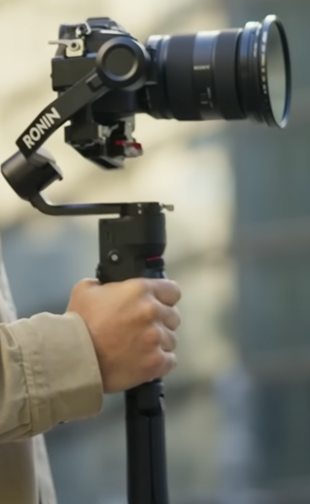

Novice pilots will appreciate the simplified remote controller, including dedicated camera buttons, so you spend less time digging into menus. Additional handy pre-programmed QuickShots modes help capture complex shots automatically with just a tap.
So, if you want an easy-to-fly drone that goes anywhere and captures fantastic footage, the DJI RS 3 Mini packs a stabilized camera, intelligent flight modes, safety sensors, and more into an ultraportable frame. It over-delivers features despite its size and class.
Pros
- Portable and lightweight
- Intelligent shooting and flight modes
- Good battery life
- Obstacle detection and avoidance sensors
Cons
- Expensive for its size
4. Zhiyun Weebill 3S
The Zhiyun Weebill 3S is a fantastic gimbal stabilizer that helps capture smooth and professional-looking videos. With its sleek design and advanced features, this gimbal stands out for both beginners and experienced videographers.
The Weebill 3S offers intuitive controls, making it user-friendly for those new to gimbals. Its ergonomic design provides comfortable handling, reducing fatigue during extended shooting sessions.
The touchscreen interface simplifies navigation through settings and modes, enhancing the overall user experience.
This gimbal excels in its stabilization capabilities, providing steady footage even when filming fast-paced movements or walking. The upgraded algorithms contribute to better stabilization, ensuring shake-free videos across different shooting scenarios.
Another highlight is its versatile modes, including inception mode for creative 360-degree shots, vortex mode for dynamic spins, and mimic motion control for replicating camera movements. These modes add a creative edge to video content.
The battery life is commendable, offering extended usage without frequent recharges, which is crucial for uninterrupted filming sessions. Additionally, the innovative latch design enables quick and secure camera mounting, saving time during setup.
However, some users might find the learning curve steep when exploring all the functionalities. It might take a bit of time to fully grasp all the features and get the most out of this gimbal.
In conclusion, the Zhiyun Weebill 3S is a top-notch gimbal that delivers exceptional stability and versatility for videographers. Its robust build, user-friendly interface, and advanced features make it a valuable tool for creating professional-quality videos.
Pros
- Stable and Versatile
- Great Payload capacity
- Easy to controls
- Stabilization is easy
- Different Modes
- Battery runtime
Cons
- Complex to set up
5. Zhiyun Crane 4
The Zhiyun Crane 4 is a remarkable gimbal stabilizer designed to elevate your videography experience. Combining innovation with functionality, this gimbal stands out as a reliable tool for both amateur and professional videographers.
Its standout feature lies in its exceptional payload capacity, enabling it to support a wide range of DSLRs and mirrorless cameras along with various lens setups.
This flexibility allows users to explore diverse shooting styles without compromising stability. Ease of use is another notable aspect of the Crane 4. Its ergonomic design and intuitive controls make it user-friendly, even for beginners.
The quick setup and balancing procedures simplify the initial process, allowing users to focus on capturing stunning footage.
The gimbal’s three-axis stabilization system performs exceptionally well, ensuring buttery smooth footage even in dynamic and fast-paced shooting situations.
This feature is especially beneficial for capturing action shots or filming while on the move. Furthermore, the Crane 4 offers multiple shooting modes, including Pan Follow Mode, Lock Mode, POV Mode, and Vortex Mode, empowering users to unleash their creativity and capture diverse perspectives effortlessly.
The inclusion of a focus wheel and a dedicated OLED display for real-time monitoring adds a professional touch to the gimbal, enhancing precision and control over the filming process.
However, some users might find the weight of the Crane 4 a bit cumbersome, especially during prolonged use. Additionally, while the gimbal is packed with features, mastering all functionalities might require some time and practice.
The Zhiyun Crane 4 is a powerhouse gimbal that excels in stability, versatility, and ease of use. Its robust build, impressive payload capacity, and advanced features make it a valuable asset for videographers looking to capture smooth and professional-quality footage.
Pros
- Payload capacity
- Controls are easy
- Stabilization
- Many modes
- Ergonomic design
Cons
- Heavy in weight
- Learning Cure
Buying guide for Best Gimbal for Canon EOS R5
The Canon EOS R5, renowned for its exceptional imaging capabilities and 8K video recording, requires a compatible gimbal for optimal stabilization and enhanced videography.
Choosing the right gimbal involves assessing various factors to meet the demands of the camera and your shooting preferences.
Payload Capacity- The first and foremost consideration when selecting a gimbal for the EOS R5 is its payload capacity. The combined weight of the camera body, lenses, and additional accessories should fall within the gimbal’s weight capacity. Aim for a gimbal that comfortably supports the EOS R5’s weight without strain.
Stabilization Technology- The gimbal’s stabilization technology plays a pivotal role in ensuring smooth footage. Look for gimbals equipped with advanced 3-axis stabilization systems that effectively counteract vibrations and movements, providing steady shots across various shooting scenarios.
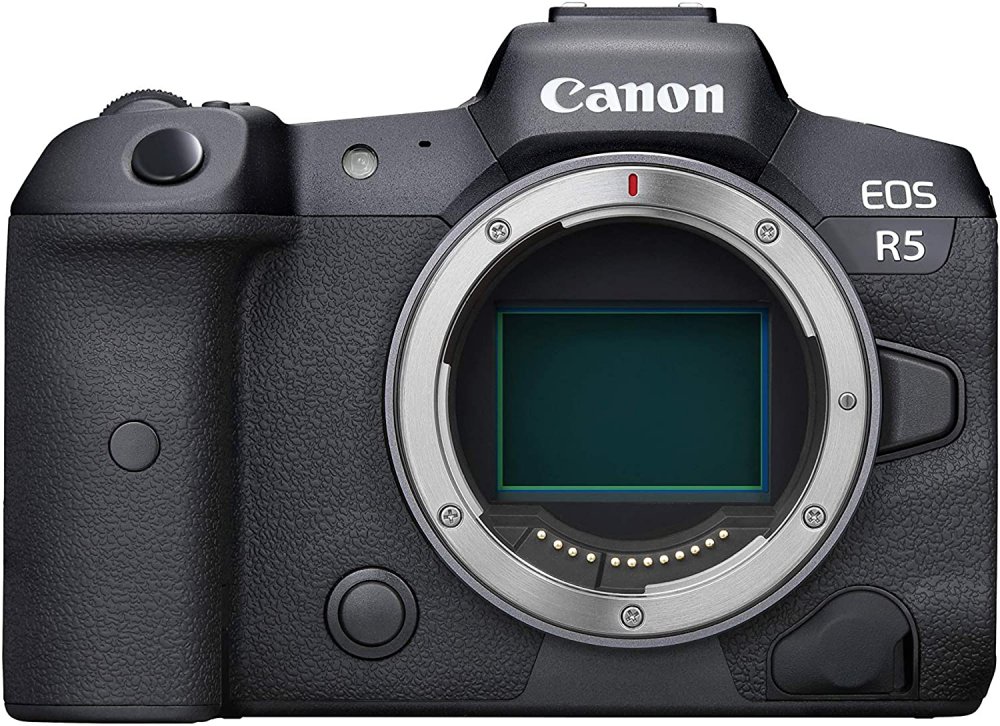
Battery Life- Longer battery life is crucial for uninterrupted filming sessions. Evaluate the gimbal’s battery performance to ensure it aligns with your shooting needs. Gimbals with extended battery life are preferable, reducing the hassle of frequent recharging.
Compatibility and Mounting- Ensure the gimbal is compatible with the Canon EOS R5. Check for the necessary mounting plate or attachment system that securely holds the camera in place. Compatibility ensures seamless integration and prevents any issues during shooting.
Portability and Weight- Consider the gimbal’s weight, especially if you plan to shoot for extended periods or while traveling. Opt for a lightweight and portable gimbal without compromising stability. This ensures ease of handling and reduces fatigue during prolonged shooting sessions.
Control and Feature- Evaluate the gimbal’s control options and additional features. Look for gimbals offering various shooting modes like pan, follow, lock, and specialized modes for creative shots. Consider additional features such as remote control capabilities, smartphone app integration, and compatibility with focus motors or other accessories.
Individual Strengths and Weaknesses- Each gimbal in the market comes with its unique set of strengths and weaknesses. Analyze reviews, user feedback, and expert opinions to comprehend how each gimbal performs under various conditions. Assessing real-world experiences helps in understanding the practicality and reliability of the gimbal in different shooting scenarios.
Making an Informed Decision- Ultimately, the goal is to synthesize all gathered information to make a well-informed decision. Prioritize factors that align closely with your videography needs and shooting preferences. Balancing these considerations will guide you toward selecting a gimbal that seamlessly complements the Canon EOS R5, enhancing your creative capabilities without limitations.
When delving into the realm of gimbal options for the Canon EOS R5, it’s crucial to navigate beyond brand prominence or alluring marketing strategies. Instead, focus on a comprehensive assessment of the unique attributes and limitations of each gimbal. This detailed evaluation based on specific features ensures an informed decision aligned with your videography needs.
Tips for using the gimbal effectively
Balancing the Gimbal
- Step 1 – Mount the gimbal on a flat surface and power it on.
- Step 2 – Adjust the axes (pan, tilt, roll) until the gimbal is level.
- Step 3 – Mount the camera and make fine adjustments to ensure it’s balanced on all axes.
Tip – Proper balancing ensures optimal stabilization, preventing strain on the motors and ensuring smooth operation.
Familiarize Yourself with Modes
- Pan Follow Mode – Follows left-right movements, keeping the horizon level.
- Lock Mode – Locks the gimbal in a fixed position.
- Follow Mode – Follows all movements, including up-down and left-right.
- POV Mode – Provides immersive, point-of-view shots by following all movements.
Hand Positioning
- Hold the gimbal with both hands for stability.
- Use gentle movements to pan or tilt for smoother shots.
- Avoid sudden jerky movements for more natural footage.
Movement Techniques
- Walking Forward/Backward – Use slow, steady steps to maintain stability.
- Tracking Shots – Follow the subject’s movement smoothly by rotating and panning.
- Dolly Shots – Walk parallel to the subject for lateral movement shots.
Utilize Follow Focus and Zoom
- Attach a follow-focus motor for precise focusing control.
- Consider using a zoom control system for smooth zooming transitions.
Practice Smooth Transitions
- Master the art of transitioning between different shots smoothly.
- Experiment with different speeds and motions for varied effects.
Calibration and Software Settings
- Regularly calibrate the gimbal for optimal performance.
- Adjust settings like motor strength, follow speed, and responsiveness based on shooting requirements.
Battery Management
- Always carry spare batteries or a power bank for extended shoots.
- Monitor battery levels and recharge between shoots to avoid interruptions.
Use Accessories for Enhanced Shots
- Attach an external monitor for better visibility while shooting.
- Consider using a vest or support system for prolonged shoots to reduce fatigue.
Experiment with Creative Shots
- Utilize the gimbal’s capabilities to experiment with unique angles and movements.
- Try shooting low-angle or high-angle shots for added dynamism.
Pre-plan Shots and Movements
- Plan your shots in advance to ensure smoother execution.
- Visualize the sequence of movements required for the desired footage.
Post-Processing and Editing
- Use post-processing software to fine-tune footage for a polished look.
- Stabilize further if needed and add effects or transitions to enhance the final product.
Safety Measures
- Securely fasten the camera to the gimbal to prevent accidents.
- Avoid sudden movements or swings that might damage the gimbal or camera.
Regular Maintenance
- Clean the gimbal regularly to prevent dust or debris from affecting its performance.
- Check for any loose screws or parts and tighten them as needed.
Continuous Learning and Practice
- Continuously experiment and practice with the gimbal to improve your skills.
- Watch tutorials, read guides, and learn from others’ experiences to enhance your techniques.
Conclusion
In the realm of videography, the Canon EOS R5 stands as a pinnacle of technological excellence, demanding a compatible gimbal to unleash its full potential.
This article delves into crucial considerations when selecting the ideal stabilizer for this powerhouse camera, emphasizing factors like payload capacity, stabilization technology, battery life, compatibility, portability, control features, and accessories.
By evaluating gimbals based on these key aspects rather than brand prominence, users can make informed decisions aligned with their videography needs.
Ultimately, the choice of a compatible gimbal harmonizes with the Canon EOS R5, transforming videography experiences into seamless endeavors.
Optimal stabilization, versatile control options, and reliable compatibility converge to empower creators, elevating their storytelling abilities while capturing smooth and captivating footage.
The synergy between the Canon EOS R5 and a well-matched gimbal becomes the gateway to unlocking boundless creativity and professional-grade videography.


